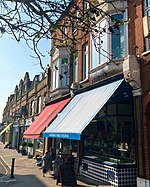St Margarets railway station (London)
DfT Category C2 stationsFormer London and South Western Railway stationsLondon stations without latest usage statistics 1415London stations without latest usage statistics 1516London stations without latest usage statistics 1617 ... and 7 more
Rail transport stations in London fare zone 4Railway stations in Great Britain opened in 1876Railway stations in the London Borough of Richmond upon ThamesRailway stations served by South Western RailwaySt Margarets, LondonTwickenhamUse British English from August 2012

St Margarets railway station, in the London Borough of Richmond upon Thames in south-west London, is in Travelcard Zone 4. It was opened by the London & South Western Railway on 2 October 1876 on the existing line from Waterloo to Windsor. It is a minor stop, 10 miles 66 chains (17.4 km) down the line from Waterloo. The station and all trains serving it are operated by South Western Railway. The station entrance is at the east end, nearer to London. The station is sometimes shown as St Margarets (London) to differentiate it from the station of the same name in Hertfordshire.
Excerpt from the Wikipedia article St Margarets railway station (London) (License: CC BY-SA 3.0, Authors, Images).St Margarets railway station (London)
Amyand Park Road, London St Margarets (London Borough of Richmond upon Thames)
Geographical coordinates (GPS) Address Nearby Places Show on map
Geographical coordinates (GPS)
| Latitude | Longitude |
|---|---|
| N 51.455 ° | E -0.3204 ° |
Address
Amyand Park Road
Amyand Park Road
TW1 2LH London, St Margarets (London Borough of Richmond upon Thames)
England, United Kingdom
Open on Google Maps







